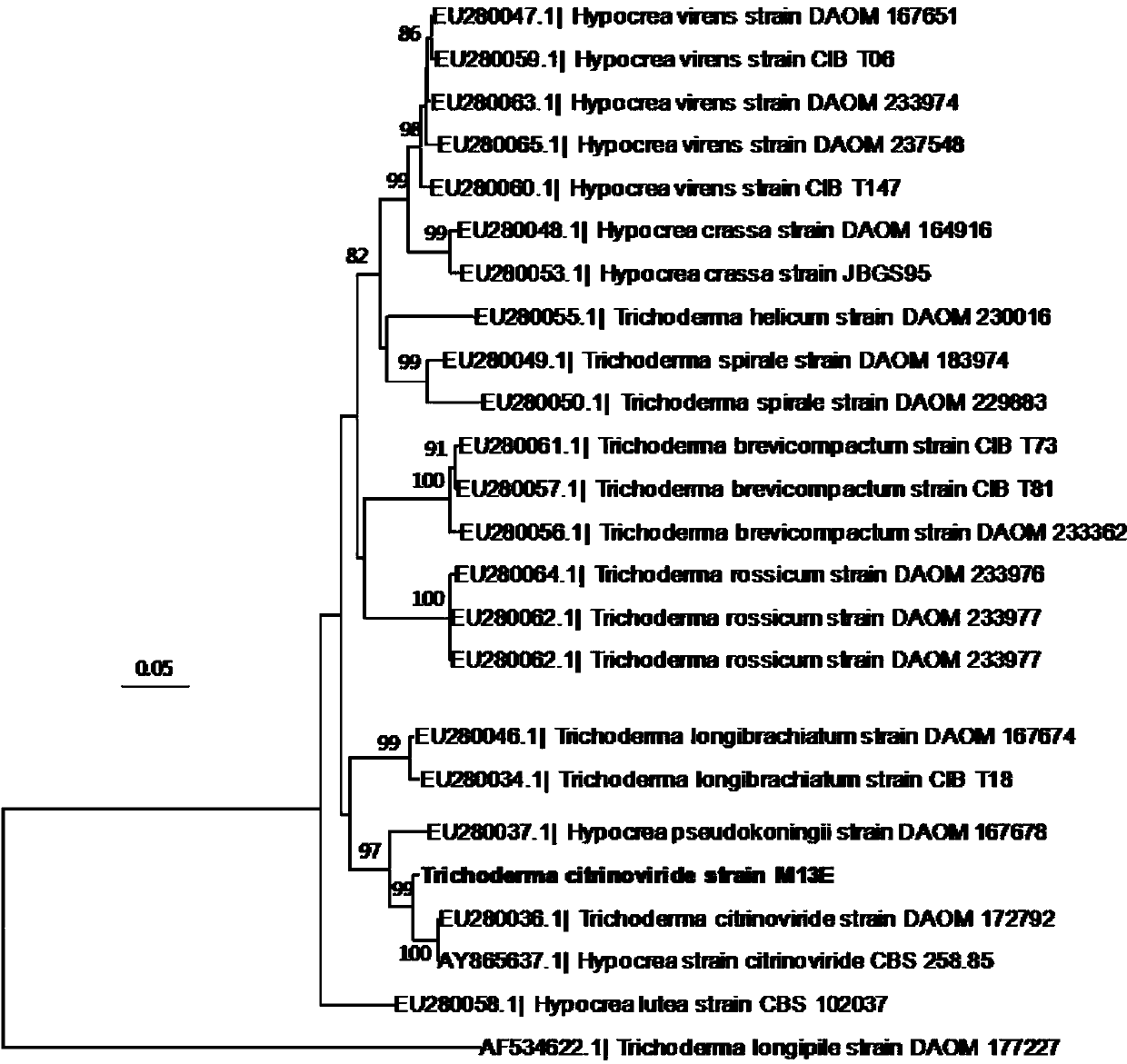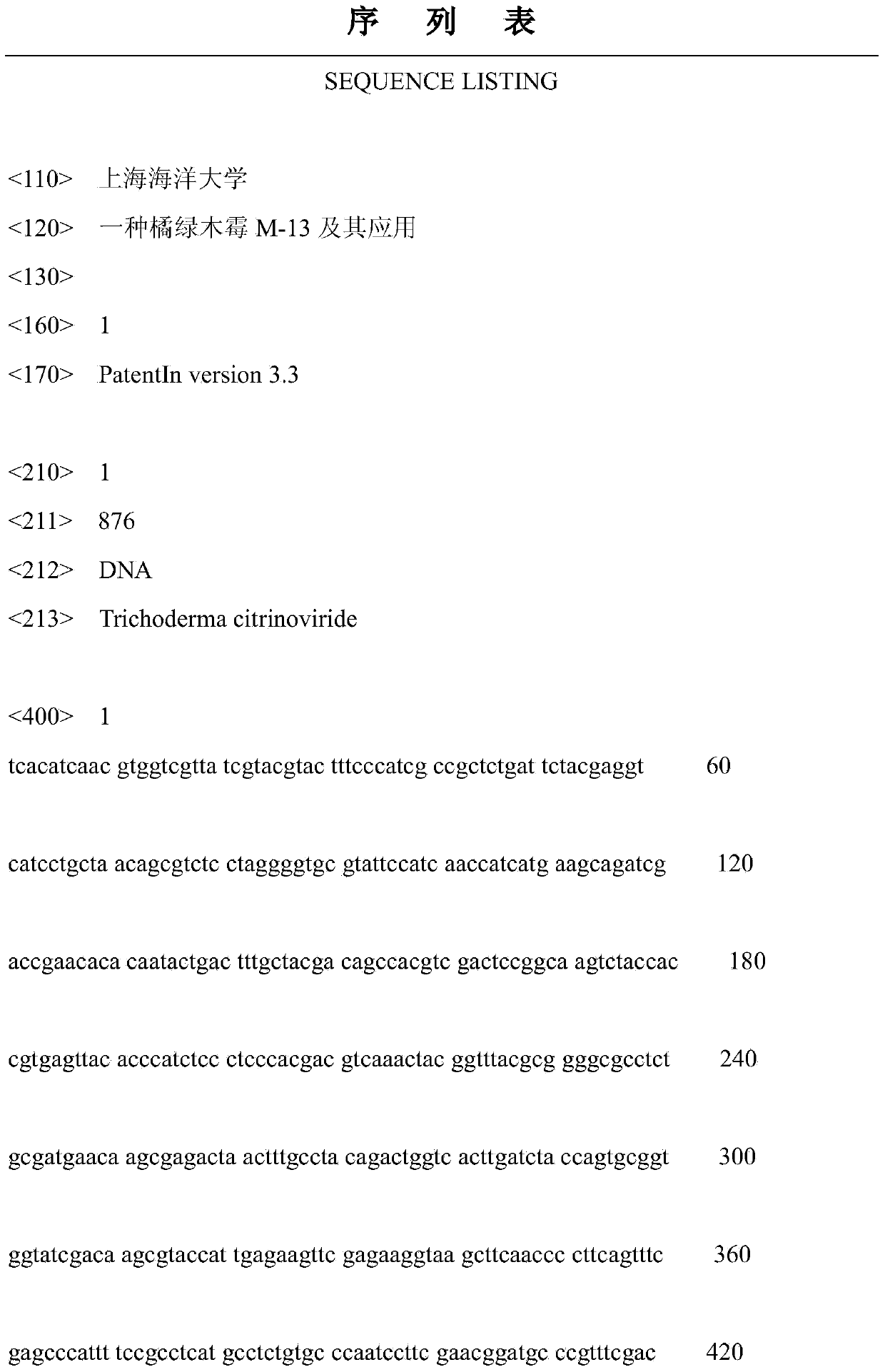Trichoderma citrinoviride M-13 and application thereof
A technology of Trichoderma tangerineum, M-13, applied in other chemical processes, water/sludge/sewage treatment, biochemical equipment and methods, etc. The effect of good application prospect, high processing efficiency and simple process
- Summary
- Abstract
- Description
- Claims
- Application Information
AI Technical Summary
Problems solved by technology
Method used
Image
Examples
Embodiment 1
[0018] strain source
[0019] An abandoned steel factory in Shanghai is located in a subtropical monsoon climate zone. Soil samples were taken from an abandoned steel factory in Shanghai in September 2012 and put into sterile bags.
[0020] Media and Reagents
[0021] Potassium dichromate (excellent grade), dry at 110°C for 2 hours before use. The reagents used in the medium (Bengal red medium, Martin medium) were purchased from Sinopharm; Taq DNA polymerase and dNTP were purchased from Dalian TaKaRa Company; DNA Marker was purchased from Beijing Tiangen Biochemical Technology Co., Ltd.; antibiotics were purchased from the UK OXOID; Milli-Q water.
[0022] Initial isolation of mold strains
[0023] Weigh 25g from the collected soil sample, dissolve it into a sampling cup (sterilized) filled with an appropriate amount of glass beads and 225mL sterile water, shake well, and dilute with 0.9% sterile normal saline gradiently to 10 -1 、10 -2 、10 -3 、10 -4 . Spread on Benga...
Embodiment 2
[0025] Example 2 Resistance to Cr 6+ Mold reduction of hexavalent chromium ions
[0026] The strain M-13 with high tolerance to slant preservation was inoculated in the non-added Cr 6+ Cultivate in liquid culture medium for 72 hours, collect mycelia, dry naturally for 4 hours, weigh 1.0 g of mycelium and place in 50ml100mg / L Cr 6+ In aqueous solution, culture at 28°C, 150r / min shaking for 48h, and filter. Measure the content of chromium ion in its filtrate with ICP-MS, repeat 3 times, calculate the average value, with no inoculation but containing 100mg / L Cr 6+ aqueous solution as a control. The strain with the best treatment effect was selected, named as M-13, and further identified.
[0027] ICP-MS detection is carried out according to the method described in the following literature:
[0028] (1) Pitt JI. 1979. The genus Penicillium and its teleomorphic states Eupenicillium and Talaromyces. London: Academic Press.
[0029] (2) Determination of hexavalent chromium in N...
Embodiment 3
[0033] Example 3 Reduction of Cr 6+ Identification of mold
[0034] 1. Molecular Systematic Identification
[0035] will be screened to highly adsorbed Cr-resistant 6+The mold was inoculated on the medium plate and cultured for 48 hours. Take a single colony and culture it on a shaker in a liquid medium for 48 hours, and use quartz sand to grind the CTAB extraction method (Scott et al., 2000, DNA heteroduplex fingerprinting in Penicillium. In: Samson RA, Pitt JI (eds). Integration of modern taxonomic methods for Penicillium and Aspergillus classification.Amsterdam: Harwood Academic Publishers.p.225–236), the DNA of the extracted strain was used as a template for PCR amplification. The translation elongation factor (tef1-alpha) gene (tef) was selected, and the amplification primers were EF1T and EF2T (Bischoff et al., 2006. Metarhizium frigidum sp.nov.: a cryptic species of M. anisopliae and a member of the M. flavoviride complex. Mycologia, 98:737–745).
[0036] PCR ampli...
PUM
 Login to View More
Login to View More Abstract
Description
Claims
Application Information
 Login to View More
Login to View More - R&D
- Intellectual Property
- Life Sciences
- Materials
- Tech Scout
- Unparalleled Data Quality
- Higher Quality Content
- 60% Fewer Hallucinations
Browse by: Latest US Patents, China's latest patents, Technical Efficacy Thesaurus, Application Domain, Technology Topic, Popular Technical Reports.
© 2025 PatSnap. All rights reserved.Legal|Privacy policy|Modern Slavery Act Transparency Statement|Sitemap|About US| Contact US: help@patsnap.com



